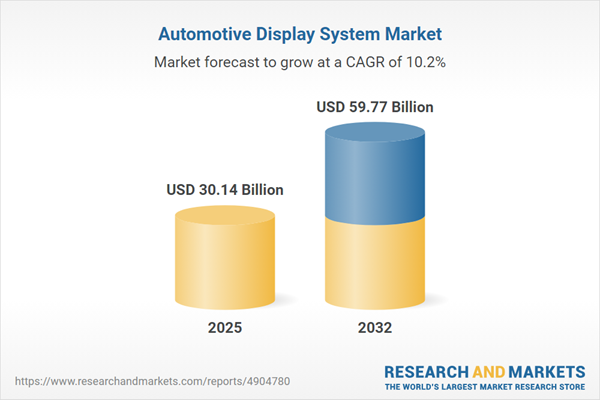Speak directly to the analyst to clarify any post sales queries you may have.
The automotive display system market is being reshaped by rapid advancements in vehicle electronics, evolving user expectations, and increasing demand for digital integration within vehicle cockpits. Senior decision-makers are seeking reliable insights to navigate complex supply chains, technology shifts, and new regulatory landscapes affecting the global market.
Market Snapshot: Automotive Display System Market Growth Trajectory
The global automotive display system market grew from USD 27.50 billion in 2024 to USD 30.14 billion in 2025. It is projected to maintain strong momentum with a CAGR of 10.18%, reaching an estimated USD 59.77 billion by 2032. Market momentum reflects rising incorporation of digital instrument clusters, infotainment units, and head-up display modules as OEMs respond to user demand for intuitive, connected, and safe driving experiences. Regional developments and regulatory factors contribute to dynamic growth patterns worldwide.
Scope & Segmentation: Comprehensive Coverage of Automotive Display System Opportunities
- Display Types: Head-up displays, infotainment displays, instrument cluster displays
- Display Technologies: LCD, LED, OLED
- Interface Technologies: Gesture-based control, touch-sensitive solutions
- Connectivity: Wired, wireless
- Resolution Types: 4K technology, Full HD, standard definition
- Vehicle Categories: Commercial vehicles (heavy, light), passenger vehicles (convertible, hatchback, sedan, SUV)
- End-users: Aftermarket, OEMs
- Sales Channels: Offline, online
- Regional Focus: Americas (United States, Canada, Mexico, Brazil, Argentina, Chile, Colombia, Peru); EMEA (United Kingdom, Germany, France, Russia, Italy, Spain, Netherlands, Sweden, Poland, Switzerland, United Arab Emirates, Saudi Arabia, Qatar, Turkey, Israel, South Africa, Nigeria, Egypt, Kenya); Asia-Pacific (China, India, Japan, Australia, South Korea, Indonesia, Thailand, Malaysia, Singapore, Taiwan)
- Key Companies Profiled: 3M Company, Alps Alpine Co., Ltd., AUO Corporation, Basemark Oy, BrightView Technologies, Continental AG, CY Vision, Denso Corporation, Futurus Technology, Garmin Ltd., HannStar Display, Hyundai Mobis, Innolux Corporation, Japan Display Inc., LG Electronics, Mitsubishi Electric, Nippon Seiki, Panasonic Holdings, Pioneer Corporation, Renesas Electronics, Robert Bosch GmbH, Sharp Corporation, Synaptics, TCL CSOT, Valeo SA, Visteon, Yazaki Corporation
Key Takeaways for Decision Makers
- Automotive display systems now serve as central hubs for telematics, navigation, and safety, moving beyond conventional driver feedback tools.
- Segmented user needs—such as commercial vehicle durability versus passenger vehicle immersion—require tailored technology strategies for sustainable growth.
- Integration of advanced connectivity enables continuous software updates and remote diagnostics, reinforcing displays as dynamic interfaces for feature deployment.
- OEMs benefit from modular, scalable software frameworks, reducing long-term hardware costs and accommodating rapid feature expansion through software adjustments.
- Collaboration between manufacturers, semiconductor vendors, and software specialists is key to delivering cohesive, future-ready cockpit solutions.
- Market success increasingly relies on balancing cost containment with innovation, particularly in light of shifting global trade and production footprints.
Assessing Tariff Impact: Strategic Response to U.S. 2025 Measures
Recent U.S. tariffs on automotive display components have prompted companies to reassess procurement strategies, diversify sourcing to North America and Europe, and seek supply chain resilience. These changes drive collaborations with regional fabricators, boost local manufacturing, and require investment in alternative materials and optimized processes to control costs without sacrificing display performance.
Methodology & Data Sources
This report leverages an integrated approach, combining secondary data from public filings and industry reports with primary interviews conducted among OEM and Tier 1 executive stakeholders. Trends are validated through proprietary case studies and collaboration with industry specialists to ensure comprehensive analysis.
Why This Report Matters: Actionable Insights for B2B Leaders
- Identify emerging trends and market drivers shaping competitive positioning worldwide.
- Support strategic planning with detailed segmentation, technology coverage, and supply chain adaptations specific to global and regional needs.
- Enable faster, evidence-based decisions and informed investments, with granular profiles of leading companies and innovation channels.
Conclusion
The automotive display system landscape is transforming with digital integration, user-centric design, and resilient strategies for sourcing and technology. This report enables decision-makers to confidently navigate upcoming shifts and harness opportunities in next-generation cockpit innovations.
Additional Product Information:
- Purchase of this report includes 1 year online access with quarterly updates.
- This report can be updated on request. Please contact our Customer Experience team using the Ask a Question widget on our website.
Table of Contents
3. Executive Summary
4. Market Overview
7. Cumulative Impact of Artificial Intelligence 2025
Companies Mentioned
The companies profiled in this Automotive Display System market report include:- 3M Company
- Alps Alpine Co., Ltd.
- AUO Corporation
- Basemark Oy
- BrightView Technologies, Inc.
- Continental AG
- CY Vision
- Denso Corporation
- Futurus Technology Co.Ltd
- Garmin Ltd.
- HannStar Display Corporation
- Hyundai Mobis Co., Ltd.
- Innolux Corporation
- Japan Display Inc.
- LG Electronics Inc.
- Mitsubishi Electric Corporation
- Nippon Seiki Co., Ltd.
- Panasonic Holdings Corporation
- Pioneer Corporation
- Renesas Electronics Corporation
- Robert Bosch GmbH
- Sharp Corporation
- Synaptics Incorporated
- TCL China Star Optoelectronics Technology Co.,Ltd.
- Valeo SA
- Visteon Corporation
- Yazaki Corporation
Table Information
| Report Attribute | Details |
|---|---|
| No. of Pages | 194 |
| Published | November 2025 |
| Forecast Period | 2025 - 2032 |
| Estimated Market Value ( USD | $ 30.14 Billion |
| Forecasted Market Value ( USD | $ 59.77 Billion |
| Compound Annual Growth Rate | 10.1% |
| Regions Covered | Global |
| No. of Companies Mentioned | 28 |









